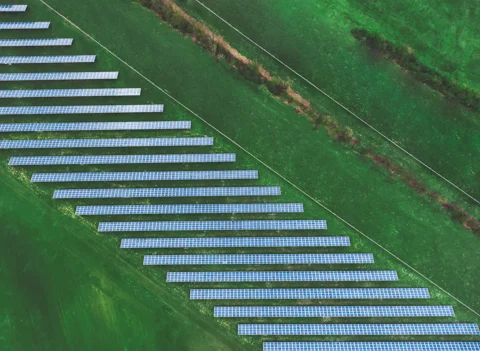It was a good thing that the urgency of global CO2 reduction was placed high on the agenda again in ‘Glasgow'. But it is all by far not fast enough for Derk Welling. As a Senior Responsible Investment & Governance Specialist he and his colleagues verify every real estate investment made by APG on sustainable criteria. And that is a major challenge.
“Of course it's a good thing the world is forcing us again to face the facts of having to reduce the global CO2 emission really very quickly,” says Welling looking back on the international climate summit in Glasgow. But if you ask him point blank, things are going far too slowly. “APG is convinced that we shouldn't wait for new regulations to be implemented, but that we have to assume the challenge ourselves and take our corporate social responsibility. That is also what people expect from us. It is a pity that we meanwhile have such an enormous number of global environmental standards in the field of real estate, some two hundred all together. This means people do not see the wood for the trees anymore. Moreover, such a large number of standards gives rise to divergent interpretations and, as a result, in greenwashing. We really need unequivocalness. That is the reason why we partly initiated a standard such as the Carbon Real Estate Monitor. That standard shows the amount of CO2 and kWh a country is allowed to emit or consume annually per square meter per type of real estate up to 2050 in order to remain within the objectives of the Paris Climate Agreement. This CRREM aims at the establishment of a global standard used to measure to what extent a real estate object meets the Paris Climate Agreement.”
What is the contribution of real estate worldwide to the climate problem?
“It is definitely one of the most polluting industries. That is why it has our full attention. Buildings are globally responsible for approximately 30 percent of the overall CO2 emission. And account for 40 percent of the energy demand! Fortunately, the awareness of truly having to do something about it now is increasing. Also within APG. When I started working here four years ago, our Global Responsible Investment & Governance team had thirteen employees and has meanwhile expanded to 28. And that is highly necessary, as we verify all investment plans in different sustainable criteria. That is part of the policy of APG and its customers: we assess every investment based on risks, returns, costs and ESG. These factors are also mutually influencing. Some real estate investments also increase in value as sustainability increases.”
How does APG ensure that it continues to make progress when it comes to sustainability?
“We have been using the Global Real Estate Sustainability Benchmark (GRESB) since 2009, a commonly used standard for the assessment of real estate investments. That standard was developed by APG in 2009, together with a number of other organizations. GRESB is perfectly suited to measure the sustainability performance of real estate investments. More than 55 percent of our real estate investments are meanwhile scoring four or the maximum five stars. Maybe even more important is that we make participation in GRESB mandatory for any new investments. As of last year, we also commit to the CRREMM, the standard we developed in collaboration with PGGM and other investors. Through so-called pathways, or CO2 reduction pathways, it is possible to see how much energy a building is allowed to consume. This is a way to reverse-calculate if and when the insulation in a building should be improved.”
What are the benefits of the above for APG as an investor in concrete terms?
“Well, it allows us, for instance, to set requirements in advance for the real estate we are willing to invest in. For our investment VIA Outlets, among other things known for Batavia Stad, we have paid a lot of attention to the sustainability performance and imposed some requirements in that respect. VIA Outlets is now challenging the clothing stores in their outlets to make their business operations more sustainable. This is a way, as an investor, to contribute to the process of companies integrating sustainability into their processes. It should further be added that in practice we often work together with other investors which means we sometimes also have to convince those other parties. We are, in principle, never the sole investor in a fund.”
So, APG wants to see the sustainability performance of real estate in which an investment is made or not made. Are the building owners or the managers or tenants of all of those buildings cooperating adequately when it comes to providing the proper sustainability data?
“That is indeed a challenge. We often hear that parties have no insight into the energy consumption of buildings. That is way too easy for me. From own experience, I know it sometimes requires having to go to much greater lengths. In some countries data on energy consumption by private tenants and companies are considered too privacy sensitive. That to me is one of the reasons to make an increasing use of certified data in the future. Not just at portfolio level, but even at building level. A daunting task as APG is globally investing in about one hundred thousand buildings.”
This means you strive for insight into all the climate effects of each of those buildings. Surely, that is an impossible task?
“Yet, we have already come a long way. We have created a database containing the geo-coordinates of all the buildings we invest in. Our asset managers provide a quarterly update on those data. We are able to zoom in up to street level. We then look locally into the influence of climate change. Think of tornadoes, floods and forest fires; disasters caused by climate change that can damage or destroy the properties.
In addition to these physical risks, we are now also expanding the database with the CO2 emission and the kWh energy consumption per square meter of the building. This provides us with a proper overview of the climate risks in our portfolio. We also use these data to engage in conversations with the local manager and the real estate companies to see whether they share our vision. This to understand to what extent they are working on making the portfolio Paris proof and whether they also take into account the physical consequences of climate change.”
Isn't it true that real estate owners will also be able to trade CO2 rights soon?
“Yes, preparatory work is currently undertaken in European context. In such Emission Trading Scheme real estate owners, given a certain CO2 limit, will be able to purchase rights to emit more CO2 where needed. If one emits less than the rights obtained, it will be possible to sell those rights. This means the polluter will pay the bill. We obviously want to prevent us from ending up in that situation with regard to our real estate investments.”



